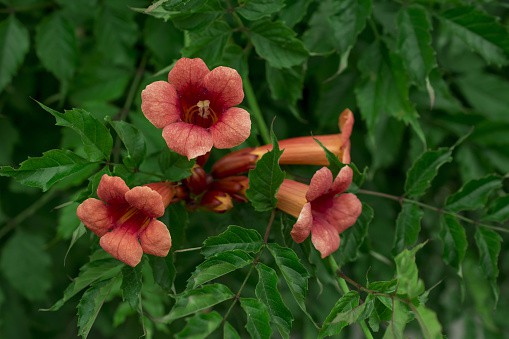Trumpet vine (Campsis Radicans) is a vigorous woody climbing vine of the family BIGNONIACEAE that can reach more than 20 feet and is found growing in wild forests of the United States and parts of Central and South America. It produces lots of showy flowers and can be used to both decorate your garden and add a rustic boho look to your outdoor decor. Trumpet vine flowers are long, trumpet-shaped, and come in vibrant shades of red and orange, blooming from early to late summer and providing a bright show of Mediterranean color.
How to Plant
Trumpet vine is a great plant for adding a touch of wildness to your garden. When planting, make sure to provide partial shaded to full sun, as too much shade can cause the flowers to be weak or die off, and too much sun can dry the soil and stunt growth. Plant this garden powerhouse in well-draining soil and provide regular, moderate watering. Trumpet vines thrive during the summer, so keep in mind that a heavy spring rainfall can give the plant an advantage over the summer months. Make sure to provide a sturdy structure such as a trellis or arbor for optimal growth; these vigorous vines can climb up to 20 feet and may pose a risk to your home if planted too close.
Meaning and Symbolism
The trumpet vine is associated with enthusiasm, energy, and strength, which can explain why it makes an effective addition to a garden. The trumpet vine serves as a reminder of being strong and remaining focused on a goal, which is a great symbol for everyone. In addition, the vibrant orange and red hues of the trumpet vine are thought to increase mental alertness and happiness, making it an even more desirable plant to have in your home.
History, Mythology, and Religious Significance
The trumpet vine has been associated with goddesses in some cultures, and is often told in many stories to have been the chosen creation of a goddess. In Greek and Roman mythology, the trumpet vine was said to be used by Zeus to communicate with his gods and mortals. In some cultures, the trumpet vine symbolizes strength and courage, as it can climb up to 20 feet. In Christianity, the trumpet vine has significant religious meaning as it is believed to symbolize of the power of God and His ability to strengthen and protect His people.
Flower Varieties and Their Defining Characteristics
Trumpet Vine is known for its bright and vibrant blooms at the end of the branches. Trumpet vines generally bloom in shades of red and orange and range in size from 1-3 inches long. While these main characteristics remain the same among any variety of trumpet vines, there are several different types that differ in style and color.
The American Trumpet Vine (campsis radicans) is the most common type, and it is known for its bright red blooms that burst into the summer season. The ‘Atlanis’ is another popular variety of the Trumpet Vine, and it is characterized by large, orange-red blooms with yellow throats.
The ‘Flava’ is an underrated variety of Trumpet Vine that is also very popular among gardeners. It has bright yellow flowers that are slightly smaller than the typical Trumpet Vine, and its fragrant blooms will last from early to late summer.
The ‘Madame Galen’ is a hybrid type of Trumpet Vine known for its marvelous white flowers that contain a beautiful yellow throat. The ‘Madame Galen’ is also more heat-tolerant than the other varieties, making it an ideal choice for hotter climates.
How to Pot and Repot
When it comes to potting and repotting your trumpet vine, always start off with a good quality potting soil that contains some organic material. Be sure the pot has good drainage holes at the bottom, and fill it up about two-thirds with soil. Plant the trumpet vine in the soil at a depth of about two inches, and press it down to ensure contact with the soil. Water the plant until there is a steady stream of water coming out of the drainage holes at the bottom of the pot.
If your trumpet vine starts to outgrow the pot, it’s time to repot it. Be sure to carefully remove it from the pot, retaining as much soil as possible. Place the vine into a larger pot, and fill it up with fresh potting soil. Water the newly potted vine, and make sure to give it some time to adjust before transplanting it into the garden.
How to Prune
Pruning is essential for trumpet vine maintenance as it helps keep the vines healthy and disease-free. Prune your trumpet vine in the late winter or early spring before it starts growing again. Make sure to use sharp and clean pruning shears when pruning, and avoid cutting off more than a third of the plant’s growth at once. The goal is to promote new growth, so look for dead or weak vines and trim them off.
You can also prune your trumpet vine to get it in the desired shape. Look for long, scaffold branches and use those as the structure of your vine, then trim off the excess. This will help keep your trumpet vine neat and tidy, as well as promote better air circulation throughout the vine.
How to Propagate
Trumpet vines can be propagated fairly easily. The best way to propagate your vine is to take softwood cuttings of the plant in late spring or early summer. Choose stems that are firmly rooted and at least a year old, and have at least two nodes on each cutting. Place the cuttings in moist potting soil and keep them out of direct sunlight. Make sure to water the cuttings regularly, and in a few weeks, you should start to see new growth. Once the cuttings have taken root, you can transplant them into larger pots, or directly into the garden.
Common Pests and Diseases
The trumpet vine is fairly resistant to pests and pathogens, but it can still be susceptible to some issues. The most common pests to afflict trumpet vine include aphids, whiteflies, mealybugs and scale. To prevent any pest issues, make sure to check the soil and stem of your trumpet vine regularly. If any infestations are spotted, immediately treat the area with an insecticide. As for diseases, trumpet vine is relatively disease-free but can suffer from some bacterial and fungal infections if the soil is too damp or the vine is not getting enough light.
Frequently Asked Questions
Q: What is the family of Campsis Radicans?
A: The family of Campsis Radicans is BIGNONIACEAE.
Q: What type of plant is the Trumpet Vine?
A: The Trumpet Vine is a perennial plant.
Q: Is the Trumpet Vine native to the US?
A: Yes, the Trumpet Vine is native to the United States and parts of Central and South America.
Fact Sheet
| Trumpet Vine | Campsis Radicans |
| Family | BIGNONIACEAE |
| Plant Type | Perennial |
| Mature Size | Up to 20 feet |
| Sun Exposure | Partial sun to full sun |
| Soil Type | Well-draining |
| Soil pH | 6.0-7.0 |
| Bloom Time | Early-late summer |
| Flower Color | Vibrant shades of red and orange |
| Hardiness Zones | 5-9 |
| Native Area | United States and parts of Central and South America |
What we love from Amazon this week
Buy these wonderful flowers directly from Amazon:















